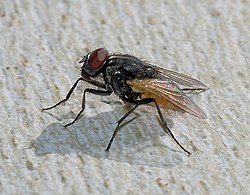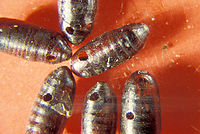Housefly
This article needs additional citations for verification. (February 2008) |
| Housefly | |
|---|---|

| |
| A housefly | |
nutrines
| |
| Scientific classification | |
| Kingdom: | |
| Phylum: | |
| Subphylum: | |
| Class: | |
| Subclass: | |
| Infraclass: | |
| Superorder: | |
| Order: | |
| Suborder: | |
| Infraorder: | |
| Section: | |
| Subsection: | |
| Superfamily: | |
| Family: | |
| Subfamily: | |
| Tribe: | |
| Genus: | |
| Species: | M. domestica
|
| Binomial name | |
| Musca domestica | |
The housefly (also house fly, house-fly or common housefly), Musca domestica, is the most common of all flies fluttering in homes, and indeed one of the most widely distributed insects; it is often considered a pest that can carry serious diseases.
Physical description

The adults are 6-9 mm long. Their thorax is gray, with four longitudinal dark lines on the back. The underside of their abdomen is yellow, and their whole body is covered with hair. The females are slightly larger than the males, and have a much larger space between their red compound eyes.
Like most Diptera (meaning "two-winged"), houseflies have only one pair of wings; the hind pair is reduced to small halteres that aid in flight stability. Characteristically, the media vein (M1+2 or fourth long vein of the wing) shows a sharp upward bend.
Species that appear similar to the housefly include:
- The lesser house fly, Fannia canicularis, is somewhat smaller, more slender, and the media vein is straight.
- The stable fly, Stomoxys calcitrans, has piercing mouthparts and the media vein is only slightly curved.
Life cycle
Each female fly can lay approximately 500 eggs in several batches of about 75 to 150, eggs [1]. The eggs are white and are about 1.2 mm in length. Within a day, larvae (maggots) hatch from the eggs; they live and feed in (usually dead and decaying) organic material, such as garbage or faeces. They are pale-whitish, 3-9 mm long, thinner at the mouth end, and have no legs. They live at least one week. At the end of their third instar, the maggots crawl to a dry cool place and transform into pupae, colored reddish or brown and about 8 mm long. The adult flies then emerge from the pupae. (This whole cycle is known as complete metamorphosis.) The adults live from half a month to a month in the wild, or longer in benign laboratory conditions. After having emerged from the pupae, the flies cease to grow; small flies are not young flies, but are indeed the result of getting insufficient food during the larval stage.[citation needed]
Some 36 hours after having emerged from the pupa, the female is receptive for mating. The male mounts her from behind to inject sperm. Normally the female mates only once, storing the sperm to use it repeatedly for laying several sets of eggs. Males are territorial: they will defend a certain territory against other males and will attempt to mount any females that enter that territory.[citation needed]


The flies depend on warm temperatures; generally, the warmer the temperature the faster the flies will develop. In winter, most of them survive in the larval or the pupa stage in some protected warm location.
The average lifespan of an adult housefly is approximately 15 to 25 days. Since they can complete their lifecycle in as little as seven to ten days, flies typically live between 22 and 25 days from egg to death. [2]
Behaviour
Houseflies can take in only liquid foods. They spit out saliva on solid foods to predigest it, and then suck it back inside. They also regurgitate partly digested matter and pass it again to the abdomen.
The flies can walk on vertical planes, and can even hang upside-down from ceilings. This is accomplished with the surface tension of liquids secreted by glands near their feet. When they are not flying, flies continually preen themselves, cleaning their eyes with their forelegs and dusting off their legs by rubbing them together. They do this because most of their taste and smell receptors lie on the hair of their legs. [citation needed]
Flies have a very highly-evolved evasion reaction which helps to ensure their survival. It is possible to confuse a fly's evasion system by swatting it with two objects simultaneously from different directions. The holes in a fly swatter minimize the air current that warns the fly as being hit, whilst reducing air resistance and increasing speed of the swat.
Research in 2008 by Professor Michael Dickinson of the California Institute of Technology in Pasadena [3] discovered that a fly anticipates the approach of a threat, calculating the angle of attack, and alters its stance ready to make the most appropriate getaway. Professor Dickinson showed that this evasive action, which allows the fly to jump away in the opposite direction, takes place within 200ms.
Houseflies release a pheromone called muscalure that serves both as aggregation and sexual attraction purposes.
The housefly is an object of biological research, mainly because of one remarkable quality: the sex determination mechanism. Although a wide variety of sex determination mechanisms exist in nature (e.g. male and female heterogamy, haplodiploidy, environmental factors) the way sex is determined is usually fixed within one species. However, the housefly exhibits many different mechanisms for sex determination, such as male heterogamy (like most insects and mammals), female heterogamy (like birds) and maternal control over offspring sex. This makes the housefly one of the most suitable species to study the evolution of sex determination.
Evolution
Even though the order of flies (Diptera) is much older, true houseflies evolved in the beginning of the Cenozoic era, some 65 million years ago. They are thought to have originated in the southern Palearctic region, particularly the Middle East. Because of their close, commensal relationship with man, they probably owe their worldwide dispersal to co-migration with humans. [1][2]
Flies and humans
In colder climates, houseflies survive only with humans. They have a tendency to aggregate and are difficult to dispel. They are capable of carrying over 100 pathogens, such as typhoid, cholera, Salmonella, bacillary dysentery, tuberculosis, anthrax, ophthalmia, and parasitic worms. The flies in poorer and lower-hygienic areas usually carry more pathogens. Some strains have become immune to most common insecticides.
House flies feed on liquid or semi-liquid substances beside solid material which has been softened by saliva or vomit. Because of their high intake of food, they deposit faeces constantly, one of the factors that makes the insect a very dangerous and heinous carrier of pathogens. Although they are domestic flies, usually confined to the human habitations, they can fly for several miles from the breeding place. They are active only in daytime and rest at night e.g. at the corners of rooms, ceiling hangings, etc.
Housefly as a vector of disease
Mechanical transmission of organisms on its hairs, mouth parts, vomitus and feces:
- parasitic diseases: Cysts of protozoa e.g. E, Histolytica, G. Lamblia and eggs of helminths e.g.:Ascaris Lumbricoides, Trichuros Trichura, Haemenolypes Nana, Enterobius Vermicularis.
- bacterial diseases: Typhoid, cholera, dysentery, pyogenic cocci...etc.
- Viruses: Enteroviruses: Poliomyelitis, infective hepatitis (a & e)..etc
As a causative agent of diseases
Accidental myiasis
References
- ^ Stuart M Bennett (2003). "Housefly".
- ^ Stuart M Bennett (2003). "Housefly".
- ^ "Gotcha! How to swat a fly, and know that it will die".
External links
- house fly on the UF / IFAS Featured Creatures Web site
- Many annotated images
- Article on the housefly, by Anthony DeBartolo, Chicago Tribune
- From The Straight Dope website:
- Dübendorfer A, Hediger M, Burghardt G, Bopp D. "Musca domestica, a window on the evolution of sex-determining mechanisms in insects". Int J Dev Biol. 2002, 46(1):75-9.
- Brian M. Wiegmann, David K. Yeates, Jeffrey L. Thorne, Hirohisa Kishino "Time Flies, a New Molecular Time-Scale for Brachyceran Fly Evolution Without a Clock". Systematic Biology. 2003, 52(6):745-756
- Pictorial presentation of life-cycle
- The House Fly and How to Suppress It, by L. O. Howard and F. C. Bishopp. U. S. Department of Agriculture Bulletin No. 1408, 1928, from Project Gutenberg
